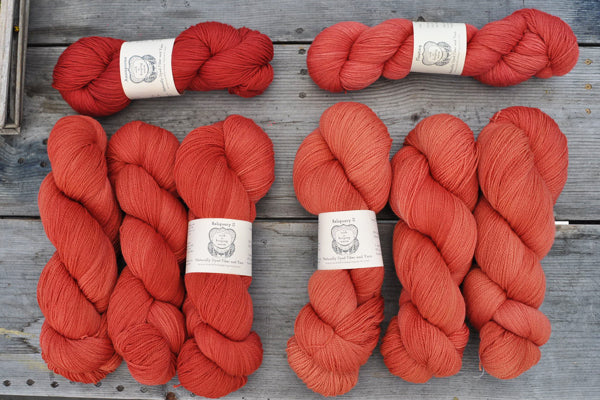One of the challenges of working in the dye studio is finding consistency in one dye lot to the next. With natural dyes, one batch of dye can vary from another due to the amount of tinctoria found in the leaves. In this case, we'll look at madder. I've always thought it would be fun to travel and collect madder from 3 or 4 different regions and to compare what kinds of red you would get from them in light of the soil and environment they are grown in. The amount of time the madder has been growing also contributes to the type of red and amount of red in the roots. The madder plant here at the shop needed to be in the ground for 2 years before we could start harvesting and dyeing with the roots. I am sure this knowledge was widely known and plants guarded long ago, what about beginning to capture this knowledge today, with where we at today with the cultivation currently. I digress.
So at the studio this week, using a newly received batch of madder, I skipped over to the dyepots, planning to dye a new batch of our saturated red colorway, Transnational Fury. At the studio, we have a book where we have recorded all of our recipes. Some are more predictable than others. As I have been on my kick to get things in the shop and studio more organized, this book doesn't get a pass. I am hoping to employ a bit more help from others in the dye studio in the upcoming year. And this is going to mean recording more through instructions next to each recipe. I record the weight of the yarn I plan to dye, and calculate the dye necessary to obtain transnational fury. Madder is the featured dye in this recipe.
Another tricky aspect to natural dyes is that when you mix them, pour them in the pot, and add yarn, the color you see is not the color you will get. As the pot heats, the color shifts. Madder always starts out brown. So when I see the color brown as I am adding the yarn, I don't think anything of it. I turn the heat on, set my timer, and walk away. Now let's add in another element, water. We have had more trouble than not getting that deep red that has more of a blue tone to it rather than an orange tone since moving into this dye studio. Our water tends to be on the acidic side of the pH scale. We can alter the water but have to be careful because by adding an alkaline and heat, you can feel it in the fiber as the hand gets slightly rougher. While I miss that blue-red, I am not sure that it is worth it to us to try and obtain it at the sacrifice of softness. Ok, let's add in one more factor. Different fibers react differently to the dyes. Superwash wools soak up the dye. In this scenario, Transnational Fury has not really been as big of a problem. Though Reliquary II which has not undergone the superwash process and is made of 80% Merino and 20% Silk (a fiber notorious for needing more dye to obtain the same level of saturation) has been a problem. As it constantly takes the dye lighter, and in this case for red-orange.
So for the past 2 1/2 years of dyeing in this studio, I've had the internal argument of whether to allow Transnational Fury to shift towards a more brick red. At this point, the Transnational Fury which is featured on the website has had a tinch of soda ash added to some of the base yarns, such as Reliquary II so that we could bump it up into the color of red we used to get at the old dye studio. I really loved that red. Though there is a larger part of me, that I would like to allow the plants and colors to speak as they are. To accept that this is what this dye studio has to give. It is still pretty. And sure, there are people who are going to bellyache that they don't like reds with orange undertones and why can't we give them a blue red, but really I don't think the red from the old studio would suffice in that case either.
One of the reasons I am drawn to work with natural dyes, and all the headaches they can cause, is that they are reflective of an environment, actually many environments all at once, where the plant was grown, the place at where it underwent the extraction process, and the place where it is dyed. It is alive. And these shifts are beautiful. Many of my natural dyeing peers are not in production, they are artists and ecologists, whose careers depend on exploring what all plants can give in terms of color. My world is almost entirely the opposite. I've had the challenge of trying to be in business as a natural dyer. The most effective way for us to reach our largest audience is through the internet and our online store. This means creating reproducible colorways so we don't have to constantly be photographing and updating our website, so a designer can work with our yarn, post a pattern, and people can use the colors and yarn the designer is using, and many other reasons.
Then there is the bookkeeping and tracking of cost, inventory, and sales. Last year, I hired a point of sale expert to help us build the infrastructure so we could track all of those things. Right now, our point of sale includes a live inventory of dyes, base yarns, and dyed yarns. What this means is that we have taken every dye recipe and base yarn combination and entered it into POS. Every time we receive a skein of let's say Reliquary II Transnational Fury, it reduces the raw amount of dye and yarn from inventory, and adds the current cost of what we purchased those materials at to the cost of the skein. As natural dyes fluctuate in price form month to month, we needed to have our finger on that pulse, and to truly understand from colorway to colorway what the cost is to make them, so in turn we could make sure that we were pricing Verb correctly. Many times we are contacted to sell wholesale. This conversation really can't be started without having a history of numbers, of the fluctuations that occur within a year, to see if we can afford to wholesale. Forget about wholesale, there is always the question of whether we are pricing Verb accurately for even us to sell. We haven't even begun to talk about labor costs. Right?
Luckily, I do have the brick and mortar shop, so that I can sometimes throw dye and yarn in a pot and see what happens, label it as limited edition, and place it in the shop for sale. Though what happens in the case, like the one with Transnational Fury, where we've ran an entire batch of yarn, washed it, dried it, begun to label it, and think - huh, I'm not sure this really can be sold as Transnational Fury. Where do we draw the line as to how far a color can deviate from the colorway. Remember all of these moments add up. It is very important for us to dye the colorway right, as each minute we spend going back and forth is keeping us from continuing our production. You know, there are just those days that you really don't want to think about these things, when really if we don't stop right there and then, and analyze why the color is not correct, we could end up making future batches which are also wrong. At which point, we end up with 12 skeins of a color that is not exactly Transnational Fury and 12 skeins which can't be listed on the website. Sure they can be for sale in the brick and mortar, there is absolutely nothing wrong with these skeins, I think they are actually better since they are reflective of the process, though the audience of who can see these skeins has now been cut in half.
So I thought I would put the question up to you - here's yarn from last week's Transnational Fury pot. In the upper right corner, you have a skein of Annapurna, made of 80% superwash Merino it is bright, saturated red. It is Transnational Fury (TF). To the right of that skein is Floating, also a pretty good representation of TF. Now looking below, you have a row of Reliquary II, all dyed in the same pot. Together the skeins look ok. Well not to me.

So I pulled them apart into 2 distinct camps. Darker, more red, on the left. Lighter, more orange, on the right.

Here's what I think needs to happen. We need to re-photograph Reliquary II for the website, accepting that it is more of a brick orange. And make a new colorway called Brick which will capture all the skeins which come out of the pot which are not quite red enough which we will photograph and add to our website. In the meantime, we are in the process of creating a thorough collection of all of our base yarns in all of our colorways and hanging them in the studio. We have bits and bobs of this kind of thing but need to pull out the entire collection. Within this collection, I would like to define what is acceptable within each colorway in terms of a color's range before it moves into a new colorway.
Believe me, I know I put myself up to the challenge of using natural dyes within a production environment. It is one which constantly fascinates me and motivates me to get out of bed in the morning. Nonetheless, there are still moments in which I desire to explore and to have a way to reach a client base, so that we can continue to depend on Verb as our income.
In May, I began a conversation with Melanie Falick of STC / Abrams about writing a book about natural dying. One thing led to the next, a book proposal, a box of naturally dyed yarn and fabric sent to NY, passing the publishing board, in other words, learning that my book proposal had been accepted, and receiving my contract - which I just signed!!

Do I really need to explain how insanely exciting this is. How much I love books. How much I love Melanie's work. And how excited I am to work on a natural dyeing project which encourages exploration - mine and yours! I can't imagine a better project to help balance all the work I have dedicated to production dyeing where we can frolic through the world of natural dyeing. There is so much fun stuff to do together - dye, knit, sew.
The plan is to have the manuscript and photography finished by Summer 2014, with the intent for it to be printed and released Fall 2015.
I have to give the hugest most heartfelt thank you to my customers, friends, and family for supporting Verb in so many ways, and giving me the time to actualize my creativity and love of natural dyes into a business. And now, a new journey to watch unfold, of course only in utmost grace ;)
To celebrate this turn of events, tell me what you would do in my case, would you have created a new colorway? To what degree do you think it is acceptable for a single colorway to vary?
Respond by next Monday at 10am, I will select someone to receive a skein of Reliquary II in Brick.
Much love!!
